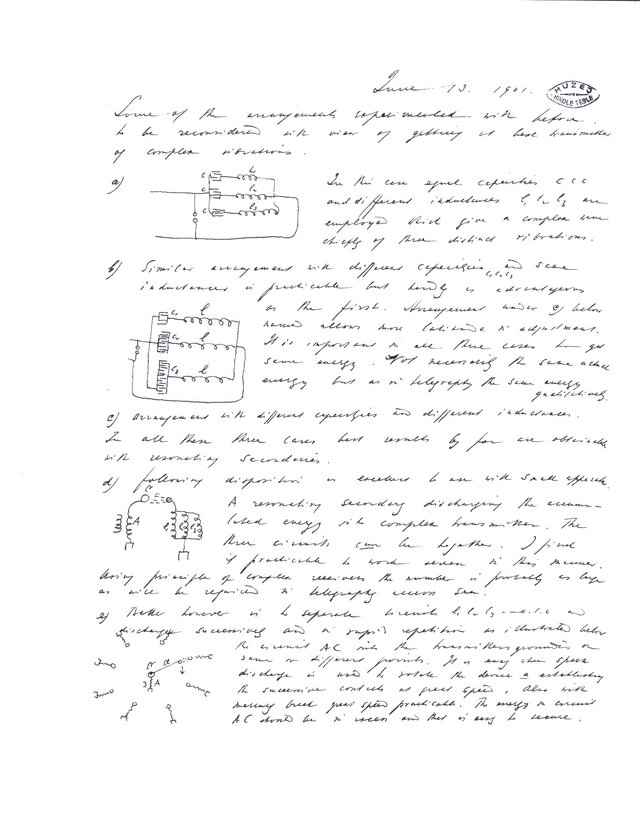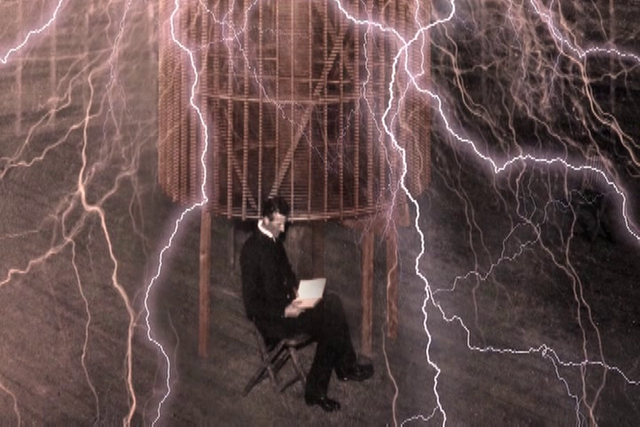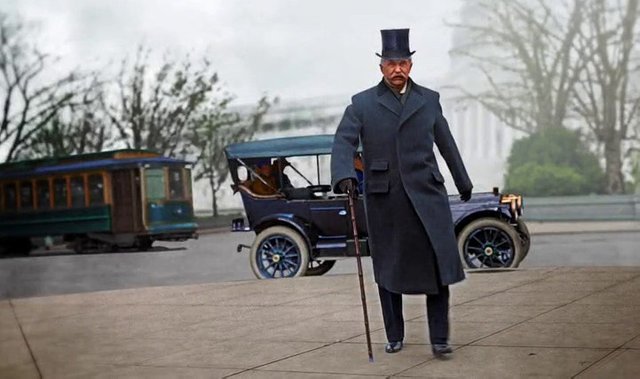Reading Nikola Tesla – part 5: Telautomatics
Here we are in 2018, over a hundred years later speculating about what could have been Nikola Tesla’s secret. I then think to myself: if only I could show you what I read, you would understand that there is no secret. When I read his articles and patents from 1900 onward, what I see is a man desperately trying to get his views across. He tries again and again in many different ways, but no-one seems to see what I see.
It is my sincere wish that one day people will read Tesla’s articles and really understand what he is saying.
So… Let me take you by the hand an walk you through his most famous article: “The Problem of Increasing Human Energy”, published in Century Illustrated Magazine of June 1900.
In this fifth part we take a look at Telautomatics, or machines that act as if they have a mind of their own.
Previous parts can be found here:
Part 1: Laying a foundation
Part 2: What is electricity?
Part 3: Burning Nitrogen...
Part 4: How to overcome natural resistance
We continue in the main article where we’d left off.
You often hear that J.P. Morgan stopped funding Tesla’s work as soon as he found out that Tesla planned to send electrical power through the Earth, saying “where do we put the meter?” This is probably not what happened as Tesla would have had an answer to this, which he explains in this part.
Yet, of course, this mentality is a retarding force that Tesla needed to alter so that it would help his project instead of opposing it. A force that can not be changed overnight as Tesla explained in the first half of this chapter. While the natural resistance of air to ionization can be overcome with a very sudden action, this retarding force is like the wheel Tesla described that can not suddenly change direction but needs to be slowed down first.
A long time ago, when I was a boy, I was afflicted with a singular trouble, which seems to have been due to an extraordinary excitability of the retina. It was the appearance of images which, by their persistence, marred the vision of real objects and interfered with thought. When a word was said to me, the image of the object which it designated would appear vividly before my eyes, and many times it was impossible for me to tell whether the object I saw was real or not. This caused me great discomfort and anxiety, and I tried hard to free myself of the spell. But for a long time I tried in vain, and it was not, as I clearly recollect, until I was about twelve years old that I succeeded for the first time, by an effort of the will, in banishing an image which presented itself. My happiness will never be as complete as it was then, but, unfortunately (as I thought at that time), the old trouble returned, and with it my anxiety. Here it was that the observations to which I refer began. I noted, namely, that whenever the image of an object appeared before my eyes I had seen something that reminded me of it. In the first instances I thought this to be purely accidental, but soon I convinced myself that it was not so. A visual impression, consciously or unconsciously received, invariably preceded the appearance of the image. Gradually the desire arose in me to find out, every time, what caused the images to appear, and the satisfaction of this desire soon became a necessity. The next observation I made was that, just as these images followed as a result of something I had seen, so also the thoughts which I conceived were suggested in like manner. Again, I experienced the same desire to locate the image which caused the thought, and this search for the original visual impression soon grew to be a second nature. My mind became automatic, as it were, and in the course of years of continued, almost unconscious performance, I acquired the ability of locating every time and, as a rule, instantly the visual impression which started the thought. Nor is this all. It was not long before I was aware that also all my movements were prompted in the same way, and so, searching, observing, and verifying continuously, year by year, I have, by every thought and every act of mine, demonstrated, and do so daily, to my absolute satisfaction, that I am an automaton endowed with power of movement, which merely responds to external stimuli beating upon my sense organs, and thinks and acts and moves accordingly. I remember only one or two cases in all my life in which I was unable to locate the first impression which prompted a movement or a thought, or even a dream.
With these experiences it was only natural that, long ago, I conceived the idea of constructing an automaton which would mechanically represent me, and which would respond, as I do myself, but, of course, in a much more primitive manner, to external influences. Such an automaton evidently had to have motive power, organs for locomotion, directive organs, and one or more sensitive organs so adapted as to be excited by external stimuli. This machine would, I reasoned, perform its movements in the manner of a living being, for it would have all the chief mechanical characteristics or elements of the same. There was still the capacity for growth, propagation, and, above all, the mind which would be wanting to make the model complete. But growth was not necessary in this case, since a machine could be manufactured full grown, so to speak. As to the capacity for propagation, it could likewise be left out of consideration, for in the mechanical model it merely signified a process of manufacture. Whether the automation be of flesh and bone, or of wood and steel, it mattered little, provided it could perform all the duties required of it like an intelligent being. To do so, it had to have an element corresponding to the mind, which would effect the control of all its movements and operations, and cause it to act, in any unforeseen case that might present itself, with knowledge, reason, judgement, and experience. But this element I could easily embody in it by conveying to it my own intelligence, my own understanding. So this invention was evolved, and so a new art came into existence, for which the name "telautomatics" has been suggested, which means the art of controlling the movements and operations of distant automatons. This principle evidently was applicable to any kind of machine that moves on land or in the water or in the air. In applying it practically for the first time, I selected a boat (see Fig. 2).
FIG. 2. THE FIRST PRACTICAL TELAUTOMATON.
A machine having all the bodily or translatory movements and the operations of the interior mechanism controlled from a distance without wires. The crewless boat shown in the photograph contains its own motive power, propelling and steering machinery, and numerous other accessories, all of which are controlled by transmitting from a distance, without wires, electrical oscillations to a circuit carried by the boat and adjusted to respond only to these oscillations.
A storage battery placed within it furnished the motive power. The propeller, driven by a motor, represented the locomotive organs. The rudder, controlled by another motor likewise driven by the battery, took the place of the directive organs. As to the sensitive organ, obviously the first thought was to utilize a device responsive to rays of light, like a selenium cell, to represent the human eye. But upon closer inquiry I found that, owing to experimental and other difficulties, no thoroughly satisfactory control of the automaton could be effected by light, radiant heat, hertzian radiations, or by rays in general, that is, disturbances which pass in straight lines through space. One of the reasons was that any obstacle coming between the operator and the distant automaton would place it beyond his control. Another reason was that the sensitive device representing the eye would have to be in a definite position with respect to the distant controlling apparatus, and this necessity would impose great limitations in the control. Still another and very important reason was that, in using rays, it would be difficult, if not impossible, to give to the automaton individual features or characteristics distinguishing it from other machines of this kind. Evidently the automaton should respond only to an individual call, as a person responds to a name. Such considerations led me to conclude that the sensitive device of the machine should correspond to the ear rather than the eye of a human being, for in this case its actions could be controlled irrespective of intervening obstacles, regardless of its position relative to the distant controlling apparatus, and, last, but not least, it would remain deaf and unresponsive, like a faithful servant, to all calls but that of its master. These requirements made it imperative to use, in the control of the automaton, instead of light or other rays, waves or disturbances which propagate in all directions through space, like sound, or which follow a path of least resistance, however curved. I attained the result aimed at by means of an electric circuit placed within the boat, and adjusted, or "tuned," exactly to electrical vibrations of the proper kind transmitted to it from a distant "electrical oscillator." This circuit, in responding, however feebly, to the transmitted vibrations, affected magnets and other contrivances, through the medium of which were controlled the movements of the propeller and rudder, and also the operations of numerous other appliances.
In this very long, but interesting paragraph Tesla explains why he was experimenting with Telautomatics. The system he envisioned needed to be similar to a living organism, in the sense that it would need motive power, organs for locomotion, directive organs, one or more sensitive organs and a controlling organ; the mind. This system would be “the world system”, Tesla would transform the Earth into a “living being”. Tesla designed all these components, but in his time he could not build a “mind” as we can today using computers. For motive power Tesla designed his “self-acting machine”, we will come to that later in this article, that derives energy from “the medium”. This power needed to be distributed (propelled, locomotion), for which he designed a method to use the Earth as a single wire distribution system. Next you would desire to be able to send power to specific (directive organ) receivers (sensitive organ), to demonstrate his solution to this problem Tesla built the world’s first radio controlled boat. Tesla refers to this as ‘the art of individualization’. The only part missing, was the mind.
By the simple means described the knowledge, experience, judgement—the mind, so to speak—of the distant operator were embodied in that machine, which was thus enabled to move and to perform all its operations with reason and intelligence. It behaved just like a blindfolded person obeying directions received through the ear.
The automatons so far constructed had "borrowed minds," so to speak, as each merely formed part of the distant operator who conveyed to it his intelligent orders; but this art is only in the beginning. I purpose to show that, however impossible it may now seem, an automaton may be contrived which will have its "own mind," and by this I mean that it will be able, independent of any operator, left entirely to itself, to perform, in response to external influences affecting its sensitive organs, a great variety of acts and operations as if it had intelligence. It will be able to follow a course laid out or to obey orders given far in advance; it will be capable of distinguishing between what it ought and what it ought not to do, and of making experiences or, otherwise stated, of recording impressions which will definitely affect its subsequent actions. In fact, I have already conceived such a plan.
Let's compare this to May 3rd, 1907: "Tesla's Tidal Wave to Make War impossible"
The telautomatic art is the result of endeavours to produce an automaton capable of moving and acting as if possessed of intelligence and distinct individuality. Disconnected from its higher embodiment, an organism, such as a human being, is a heat - or thermodynamic engine - comprising:- (1) a complete plant for receiving, transforming, and supplying energy; (2) apparatus for locomotion and other mechanical performance; (3) directive organs; and (4) sensitive instruments responsive to external influences, all these parts constituting a whole of marvellous perfection.
The ambient medium is alive with movement and energy, in a state of unceasing agitation which is beyond comprehension.
---//---
Its storage battery and motor furnished the power; the propeller and rudder, respectively, served as locomotive and directive organs, and a very delicate electrical device, actuated by a circuit tuned to a distant transmitter, took the place of the ear.
---//---
The next step was to individualise the machine. The attunement of the controlling circuits gave-it a special feature, but this was not sufficiently distinctive. An individuality implies a number of characteristic traits which, though perhaps extant elsewhere, are unique in that particular combination. Here again the animated automaton, with its nerve-signal system, was coarsely imitated. The action of the delicate device - the ear - was made dependent on a number of sensitised receiving circuits, each recognisable by its own free vibrations, and all together by the character of their operative combination. Correspondingly the transmitter was designed to emit a wave-complex exactly matching the combination in the number and pitch of individual vibrations, their groupment and order of succession.
---//---
That much is done, but more is to come. A mechanism is being perfected which without operator in control, left to itself, will behave as if endowed with intelligence of its own. It will be responsive to the faintest external influences and from these, unaided, determine its subsequent actions as if possessed of selective qualities, logic, and reason. It will perform the duties of an intelligent slave. Many of us will live to see Bulwer's dream realised.
(For those unfamiliar with Bulwer’s work, Tesla refers to “the House and the Brain”)
Tesla knew this was possible and it would necessarily come to be. Maybe he did not realise it would take so many years before the computer would be able to perform the functions he envisioned.
We continue with the main article.
Although I evolved this invention many years ago and explained it to my visitors very frequently in my laboratory demonstrations, it was not until much later, long after I had perfected it, that it became known, when, naturally enough, it gave rise to much discussion and to sensational reports. But the true significance of this new art was not grasped by the majority, nor was the great force of the underlying principle recognized. As nearly as I could judge from the numerous comments which appeared, the results I had obtained were considered as entirely impossible. Even the few who were disposed to admit the practicability of the invention saw in it merely an automobile torpedo, which was to be used for the purpose of blowing up battleships, with doubtful success. The general impression was that I contemplated simply the steering of such a vessel by means of Hertzian or other rays. There are torpedoes steered electrically by wires, and there are means of communicating without wires, and the above was, of course an obvious inference. Had I accomplished nothing more than this, I should have made a small advance indeed. But the art I have evolved does not contemplate merely the change of direction of a moving vessel; it affords means of absolutely controlling, in every respect, all the innumerable translatory movements, as well as the operations of all the internal organs, no matter how many, of an individualized automaton. Criticisms to the effect that the control of the automaton could be interfered with were made by people who do not even dream of the wonderful results which can be accomplished by use of electrical vibrations. The world moves slowly, and new truths are difficult to see. Certainly, by the use of this principle, an arm for attack as well as defence may be provided, of a destructiveness all the greater as the principle is applicable to submarine and aerial vessels. There is virtually no restriction as to the amount of explosive it can carry, or as to the distance at which it can strike, and failure is almost impossible. But the force of this new principle does not wholly reside in its destructiveness. Its advent introduces into warfare an element which never existed before—a fighting-machine without men as a means of attack and defence. The continuous development in this direction must ultimately make war a mere contest of machines without men and without loss of life—a condition which would have been impossible without this new departure, and which, in my opinion, must be reached as preliminary to permanent peace. The future will either bear out or disprove these views. My ideas on this subject have been put forth with deep conviction, but in a humble spirit.
People of his time only saw use of this invention as a torpedo in warfare. That is so typical. Here Tesla states that ‘it affords means of absolutely controlling, in every respect, all the innumerable translatory movements, as well as the operations of all the internal organs, no matter how many, of an individualized automaton.’ His world system could supply power and messages to every single specific receiver or group of receivers, and as soon as we would have computers (the ‘mind’) the whole system could run without human intervention.
The establishment of permanent peaceful relations between nations would most effectively reduce the force retarding the human mass, and would be the best solution of this great human problem. But will the dream of universal peace ever be realized? Let us hope that it will. When all darkness shall be dissipated by the light of science, when all nations shall be merged into one, and patriotism shall be identical with religion, when there shall be one language, one country, one end, then the dream will have become reality.
In Oct 25th, 1907 article “Tesla on Wireless” he elaborates a little on this art of individualization:
The underlying principle is to combine a number of vibrations, preferably slightly displaced, to reduce further the danger of interference, active and passive, and to make the operation of the receiver dependent on the co-operative effect of a number of attuned elements. Just to illustrate what can be done, suppose that only four vibrations were isolated on each transmitter. let those on one side be respectively a, b, c, and d. Then the following individualized lines would be ab, ac, ad, bc, bd, cd, abc, abd, acd, bcd and abcd.
Although Tesla had developed the method to individualize receivers he had not worked out how to implement the sender into the Magnifying Transmitter. This shows in the many ‘Long Island Notes’ in which Tesla seems to try out various methods of generating the different frequencies.

Stay tuned, much more coming your way.



This post was shared in the Curation Collective Discord community for curators, and upvoted and resteemed by the @c-squared community account after manual review.
This is fascinating on many levels, not the least of which is Tesla's anticipation of computational engines to automate thinking and control.
😄😇😄
